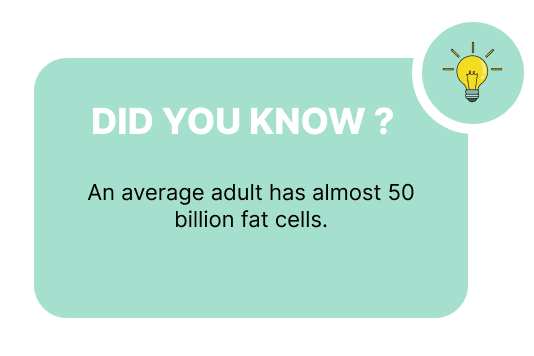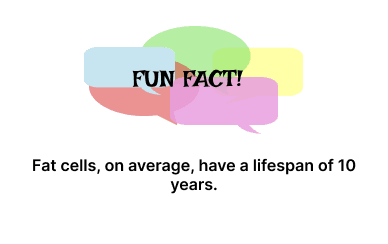How Long Does It Take To Lose Fat – A Beginner’s Guide

Weight loss is the overall reduction in body weight (including fat, muscle mass, bones, and water). In contrast, fat loss refers to reducing body fat, which is more beneficial and can’t be measured as easily as standing on a scale. Fat loss is a complex journey that depends on many factors, but the prominent ones are diet and physical activity.
Losing fat plays a big role in reducing obesity and improving overall health. However, it is also important to ensure healthy levels of muscle and lean body mass to keep the body functioning properly.
While switching to low-carb and high-fiber diets can help with weight loss, focusing on a high-protein diet is known to be more effective for losing fat, specifically. In this narrative, we’ll explore how long it takes to lose fat, tips for fat loss, and other insights.
How Fat Loss Works?
Your body needs calories to function because they provide energy for everything you do—from breathing and sleeping to eating and thinking. Calories are stored as triglycerides (fat), and when you consume more than you burn, the excess is stored in areas like the hips, thighs, and abdomen. To lose fat, you follow a calorie-deficient diet, forcing your body to use stored fat for energy. But how is fat lost? It doesn’t just vanish. Fat breaks down into carbon dioxide and water. You exhale the carbon dioxide and eliminate water through sweat, urine, and other fluids. So yes—fat mostly leaves your body through your breath.
Stored calories are converted into energy, and the body breaks down the triglycerides into water and carbon dioxide. The excretion of these products takes place gradually. Carbon Dioxide is exhaled during breathing, so when you exercise, your breathing rate increases because you are burning fat and getting rid of the byproduct. Water is discharged through sweating and urination, and some of it is excreted via breathing as well.
How Long Does It Take to Lose Fat?
When people begin their weight loss journey, they expect changes in figures and percentages after a while. However, the fat loss process is much more complicated than that, and there is no stone-set time after which you can start losing fat. Although, a tentative timeline is from 1 to 2 weeks.
Factors That Affect the Timeline
The timeline for fat loss varies significantly between individuals and depends on multiple factors. Below is a quick overview to clarify things.

- Body Composition:
- One key factor is starting body composition. Studies hint that folks with higher body fat percentage tend to lose fat more quickly initially compared to someone leaner.
- Diet:
- Diets also play a significant role in promoting fat loss. For instance, a well-structured, calorie-controlled diet paired with balanced macronutrients encourages fat loss.
- Physical Activity:
- Workout sessions, especially the ones including cardio and strength training, boost metabolism and improve the body’s ability to burn fat. Similarly, a non-sedentary or active lifestyle with a lot of walking and physical activity can also result in fat loss.
- Metabolism:
- The next thing that influences the fat loss speed is your metabolic rate. A person with a naturally higher metabolism loses fat faster than someone with a slower metabolic rate.
- Other Elements:
- Some other factors that help accomplish the fat loss stages include age, gender, and sleep quality. The general guidelines suggest that you lose only one or two pounds of fat in a week, but this timeline varies from person to person. You can consider the chart below to keep track of your fat percentage.
Note that fat levels higher than 35% of women are considered obese.
| Women | Low | Good | High | Obese |
| 30-39 | <15% | 15-20% | 21-29% | 30% and above |
| 40-49 | <15% | 15-24% | 25-30% | 31% and above |
| 50 and above | <15% | 15-27% | 28-34% | 35% and above |
What’s the timeline for burning body fat?
For women, the timeline for noticeable fat loss depends on several factors, but a healthy and realistic rate is typically 1-2 pounds of fat per week. This steady pace ensures sustainable fat loss without compromising muscle mass or health.
If you’re wondering about the timeline to lose fat, the answer can vary. Still, with consistent effort in maintaining a calorie deficit, exercising regularly, and following a balanced diet, women can start seeing changes in their body composition within a month or so. However, individual results may vary based on metabolism, fitness level, and diet. Patience and consistency are key to achieving long-term fat loss results.

Let’s Explore The Stages of Fat Loss
Fat loss is a gradual process that varies for each individual, depending on factors like metabolism, diet, and exercise routine.
Three Stages For Fat Loss
Fat loss also plays a part in overall weight loss, but measuring your weight will not necessarily indicate a loss in fat. You can examine your fat loss by measuring the body fat before and after committing to a fat loss plan.
1. Rapid Loss Phase: Initially, you’ll notice a rapid drop. This will be evident in either weight loss or how your clothes fit. However, it is important to note that during the first one or two weeks, the body doesn’t lose much fat. This drop is due to the reduction in water, protein, and glycogen. Glycogen is a backup source of energy that the body keeps in a spare.
Once the glycogen is used, the body moves to burn fat, which is the second phase.
2. Slow Loss Phase: As fat loss progresses, the second stage involves a more gradual fat reduction, where changes in body composition become noticeable, such as slimmer waistlines or toned muscles.
3. The Final Phase: The third stage is where stubborn fat, usually around the hips, thighs, or abdomen, begins to decrease. Physical changes, such as improved muscle definition and reduced body fat percentage, become more apparent with consistent diet and exercise.
| You may also like to read: Healthy Body Fat Percentage For Women |
The Best Tips to Lose Fat
Losing fat requires a smart and sustainable approach. While every body is different, the right mix of healthy habits can speed up your progress. Here are some of the most effective fat loss tips to get you started and keep you on track.

List of Tips to Enhance Fat Loss:
You’ll find countless meal replacement plans, diets, and supplements that claim rapid fat loss. However, they’ll be missing the scientific evidence. Here are some science-backed tips to conquer the different stages of losing fat.
Reduce your intake of processed foods and increase your intake of whole foods like fruits, vegetables, lean proteins, and healthy fats to create a calorie deficit.
- Prioritize protein in your meals to help preserve muscle mass during fat loss.
- Drink plenty of water to boost metabolism and reduce hunger.
- Incorporate both strength training and cardiovascular exercises into your routine.
- Engage in high-intensity interval training (HIIT) for efficient fat-burning in less time.
- Maintain consistency in your diet and exercise plan for long-term, sustainable results.
Common Pitfalls That Slow Down Fat Loss
Losing fat has two sides. First, there is the bright and shiny side, where everything goes according to plan, and then there are some common mistakes that reduce fat loss. Here is what you need to avoid.
- Focusing only on the scale rather than tracking progress through body composition changes.
- Not getting enough sleep can disrupt hormone balance and hinder fat loss.
- Underestimating calorie intake and consuming more than you think.
- Exercising too much or too little to not at all.
- Relying too heavily on cardio without incorporating other forms of exercise.
- Skipping meals or preferring low-carb products.

Conclusion
The question of how long does it take it to lose fat isn’t as straightforward as one might imagine. However, with the right approaches, one can achieve realistically healthy levels. It is important to follow healthy diets and exercise plans so your body stays in good shape. Once that is done, the rest will follow. It is also important to note that fat loss varies from person to person, which is why it is important to stay consistent in your efforts to achieve long-term success.
FAQs
1. How long does it take to notice fat loss?
There is no set duration after which one will notice fat loss. Typically, changes become visible in 1 to 2 weeks, but the period highly depends on the intensity of the fat loss program, diet, body composition and genetics.
2. Why does fat loss slow down over time?
Fat loss depends on the number of calories consumed and the number of calories burned. If you consume the same number of calories and burn the same number, you’ll have reached a plateau. To further progress in your fat loss journey it is important to increase the workout intensity and reduce the calorie intake.
3. How long does it take to lose body fat with diet and exercise?
To lose 1 pound, you have to burn at least 3500 calories. To burn this figure you have to reduce 500 calories every day and lose 4 pounds in a month via exercise. However, the rate of fat loss depends on many variables and is therefore different for everybody.
4. Can you lose fat and gain muscle at the same time?
Achieving both things together isn’t that simple but achievable if you strategize and commit to the task.
5. What are the common stages of losing fat?
There are commonly two phases, rapid fat loss and slow fat loss. In the first phase, the body only loses a bit of fat and usually loses protein and water. In the second phase, significant fat loss occurs.

